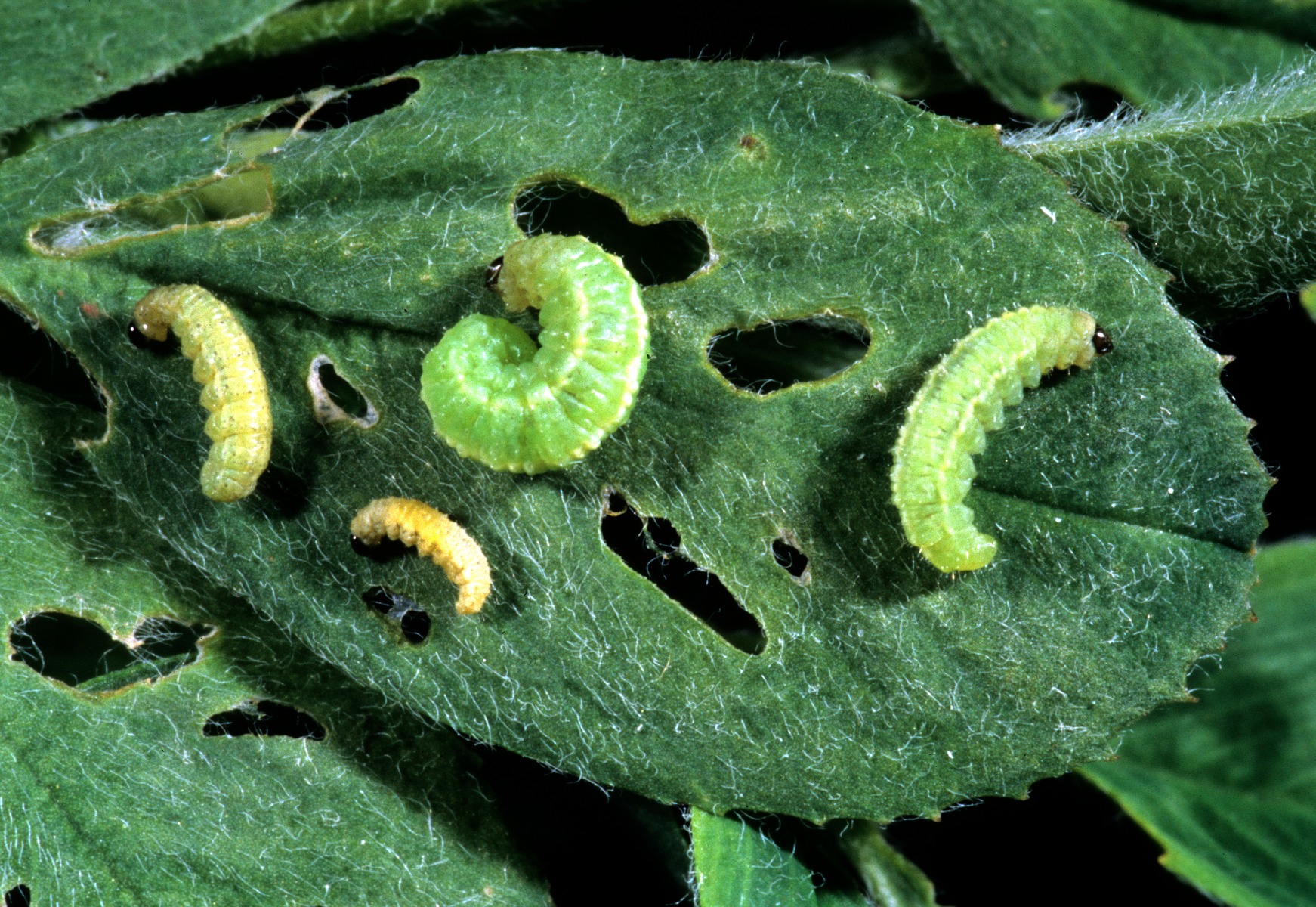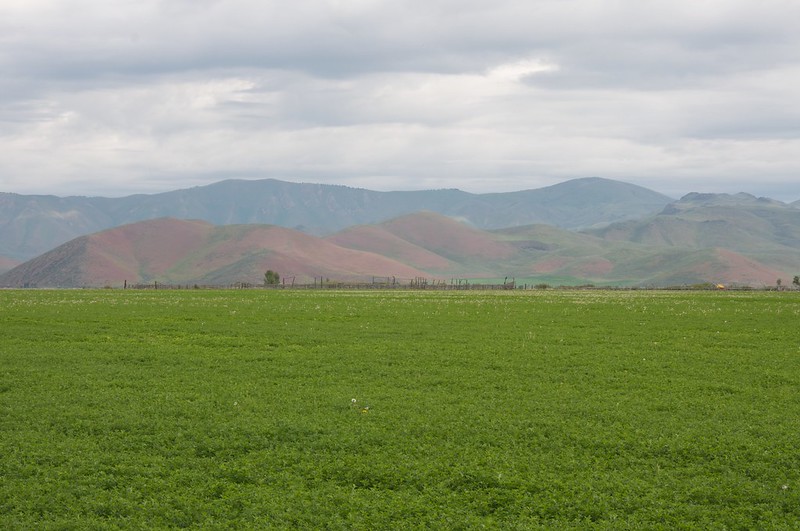Photo Credit: Sam Beebe | Flickr | CC BY 2.0 DEED
The alfalfa weevil, Hypera postica, is considered to be one of the most destructive alfalfa pests. High larval populations can cause substantial defoliation in as little as three to four days when left untreated.
No one wants to lose an entire alfalfa crop in a matter of days, whether it’s intended to be sold or used for animal feed. So, scouting for weevils is incredibly important. If you can catch an infestation early enough, you may be able to control the weevils or harvest early and recoup your financial investment.
Effective scouting means knowing how and when to look for weevils, identifying the larvae and adults, and understanding the economic thresholds.
When Should You Start Scouting?
Scouting should begin early in the season and continue through the first cutting.
Peak larval activity and associated feeding damage occur between 325 and 575 growing degree days (GDD). With this in mind, it’s recommended to start scouting at 200 GDD if you live south of I-80 and at 250 GDD if you live north of the interstate. For most growers, this usually falls about mid-May, but it can be May 1st with an early spring.
Fields with south-facing slopes should be scouted earlier, too, as they tend to warm up sooner from sun exposure.
After the first cutting, scout fields for 4 to 5 days to monitor weevil presence and feeding activity.
Alfalfa Weevil Damage Symptoms
- Alfalfa weevil larvae damage starts as small pinholes in the leaves. As the larvae grow, they chew larger holes, making the alfalfa plants look shredded. High larval populations—four or more per stem—can cause severe foliage loss in as little as three to four days, causing the field to appear grayish.
- Adult weevil damage appears as small, circular cuts along the leaf margins. Since they don’t feed as voraciously, this damage is typically minor and not as concerning.
 Photo Credit: Texas A&M Extension Entomology
Photo Credit: Texas A&M Extension Entomology
Identifying Alfalfa Weevils
Larvae are pale yellow-green larvae and small (1/16 to 3/8 inch long), becoming darker green as they grow. The legless larvae resemble plump-body maggots with blackheads and a white stripe that runs the length of their back. They have well-developed ridges on their undersides that replace their legs.

Photo Credit: Purdue University
The larvae spend nearly all their time feeding on the plant leaves. You rarely find them on the soil surface or along the alfalfa stems. When disturbed, they curl into a C-shape.
Adult weevils are one-eighth to one-quarter inch long and light brown, with a dark stripe running down the center of its back. The body color may darken as the weevil ages, making the center stripe harder to see. They have the typical medium-sized weevil snout. It protrudes downward and has chewing parts on the end used to feed with and bore holes into the stems to lay eggs.
 Photo Credit: Texas A&M Extension Entomology
Photo Credit: Texas A&M Extension Entomology
Alfalfa Weevil Life Cycle
Most alfalfa weevils overwinter in the adult form in alfalfa plant crowns, under leaves, or in field trash. Some of these adults may lay eggs in the alfalfa stems during the fall, which may survive if winter conditions aren’t too harsh.
The adults become active in the spring when temperatures climb above 48°F and begin laying eggs. Eggs laid in the fall will hatch earlier than those laid in early spring.
After hatching, the plump, green larvae feed on the folded alfalfa leaves at the growing tips. They feed ravenously as they progress through 4 instars before pupation. This cycle takes about 3 to 4 weeks, depending on the temperature and alfalfa quality, with the 3rd instar larvae being the hungriest and causing the most damage.
Larval feeding typically slows down about the time of the first cutting, although the adults will feed on the regrowth following. Hence, a need to scout routinely before the first cutting and for only a few days afterward.
 Photo Credit: Purdue University College of Agriculture
Photo Credit: Purdue University College of Agriculture
Scouting For Alfalfa Weevils
The standard way to scout for alfalfa weevils is using a sweep net and a five-gallon bucket once plants are 6-10” tall. However, if you are examining shorter stands, you’ll need to look directly at the terminal leaflets and new growth for signs of injury or the presence of larvae and adults.
If larvae are discovered in a field, estimating the number per plant is critical.
Some growers use the sweep net to determine the presence of weevil and then estimate the number of larvae in a field; others use it to determine the presence of alfalfa weevil and then use another method to determine counts per plant closely.
Using a Sweep Net
To use a sweep net, swing it in a 180º arc—from one side of your body, across in front, and to the other side—so the net’s rim strikes the top 6-8” of the alfalfa plants. You want to hold the net just less than vertical so its bottom edge hits the plants before the top edge.
 Photo Credit: Wikimedia Commons
Photo Credit: Wikimedia Commons
A common method for sweeping is to sweep from right to left, take a step forward, and sweep from left to right. Continue walking forward until you get 5 to 10 sweeps, changing the direction after every step.
After taking the desired five or ten sweeps, quickly pull your net through the air to force all alfalfa weevils into the bottom of the net bag. Grasp the bag with your hand at the mid-point to trap them in the bottom. You can then invert the net bag to count the insects or turn the net onto a white cooler lid or your vehicle's hood to get a count.
If using the sweep net to estimate population density, take samples in four field areas. Start from the field margin or headrows, working into the middle. Then, calculate the average number of larvae per sweep.
Determining Population Density Without a Sweep Net
Once you confirm the presence of weevil in alfalfa, the next step is determining population density. The population density then allows you to conclude the economic injury level (EIL) and economic threshold.
To determine the population density, you want to walk the field in either a “Z” or “M” pattern, randomly sampling 25 to 30 alfalfa plants. The goal is to take an even number of plants from each leg of the pattern. So you’ll take 8 to 10 on each leg of the “Z” and 6 to 8 on each leg of the “M.”
Pull a selected plant from the ground, hitting it against the inside of the five-gallon pail to dislodge larvae. Count the number of larvae in the bucket and measure plant height, recording both. Continue until you have reached the total sample size.
This method is more effective than counting the larvae and adult weevils in alfalfa, as the adults fall off when the plant is disturbed in self-defense.
After the whole 25 to 30 plants are sampled, calculate the average larvae per plant and the average plant height. Then, compare it to economic threshold tables.
Alfalfa Weevil Threshold
When deciding how to handle an alfalfa weevil infestation, you must look at a field's economic threshold and economic injury level.
- Economic threshold: The pest density at which action should be taken to keep a rising pest population from reaching the economic injury level.
- Economic injury level: The smallest number of insects or amount of injury that causes yield losses equal to the cost of managing the pests.
The economic threshold considers stand height, the number of larvae per stem, and the larval size.
In general:
- Alfalfa less than 12” tall should be treated with an insecticide if there are one or more large larvae per stem.
- Alfalfa 12 to 16” should be treated with an insecticide when there are 2 to 4 larvae per stem.
- Alfalfa taller than 16” with more than four larvae per stem should be harvested early.
|
Table 1. Action thresholds relevant to stand height, tip feeding, and density of larvae per stem. |
|||
|
Stand Height Inches |
Indication of Problem % Tip Feeding |
Problem Confirmation Larvae per Stem |
Recommended Action |
|
6 |
25 |
1 |
Recheck in 7 days |
|
9 |
50 |
> 1 |
Spray |
|
12 |
75 |
> 2 |
Spray |
|
16 |
100 |
> 4 |
Harvest early |
|
When harvested early due to weevil, check within one week for regrowth. |
|||
https://agcrops.osu.edu/newsletter/corn-newsletter/2022-12/alfalfa-weevil-ready-set-scout
Alfalfa Weevil Control
Depending upon the infestation severity, you have different alfalfa weevil treatment options. Biological control is a helpful tool early in the season to prevent alfalfa weevil problems or to handle small infestations.
Biological Control
While alfalfa is known to harbor various natural enemies of insect pests, biological controls for alfalfa weevil are relatively low.
Common predators that feed on larvae include ladybeetles, damsel bugs, lacewings, and some spiders.
Two parasitic wasps (Bathyplectes curculionis and Bathyplectes anurus) have been introduced into California for control, but the parasitism rate is unknown in midwestern states.
Zoophthora phytonomi, a fungal pathogen, also provides reasonable alfalfa weevil control in warm, humid conditions.
While scouting, look for larvae that aren’t the typical lime green color. The weird coloration could indicate biological control from parasitic wasps or the fungal pathogen. This activity may be enough control to keep weevils below the economic threshold. Watch if weevil numbers are rising or declining as you continue scouting.
Cultural Control Methods
The most important cultural control method is to harvest your alfalfa early if alfalfa weevil numbers are high. If your crop has reached the 50% bud stage, and larvae numbers are at or above the economic threshold, cutting your alfalfa avoids the need for using a pesticide.
 Photo Credit: Wikimedia Commons
Photo Credit: Wikimedia Commons
Bale the alfalfa as soon as possible after harvest as the insects shelter under the windrows.
Chemical Control With Insecticides
Because natural enemies have the potential to keep alfalfa weevils from reaching economic injury levels, and alfalfa harbors bees and other essential insect pollinators, only use insecticides when necessary.
Highly effective insecticides include pyrethroids (active ingredient ends in "thrin") and pesticide products containing indoxacarb.
Note: Pyrethroid insecticides also provide aphid control but may harm pollinators and beneficial insects. Indoxacarb products are more selective; they do not affect pollinators and most beneficial insects, but they also do not provide aphid control.
Need More Assistance?
Alfalfa weevil doesn’t have to wipe out your crop if you start scouting early and catch larvae populations as they reach the economic threshold for your stand height. If you need help with alfalfa management or weevil scouting, contact our certified crop advisors for help!
For more information on Deer Creek Seed's available alfalfa varieties, you can find ratings in our 2023 Seed Guide.
Additional Resources
- The University of Nebraska-Lincoln Institute of Agriculture and Natural Resources has a more in-depth economic threshold table that also accounts for crop value.
- Interested in more information on using a sweep net? This page by the University of California Agriculture & Natural Resources is a great resource.



